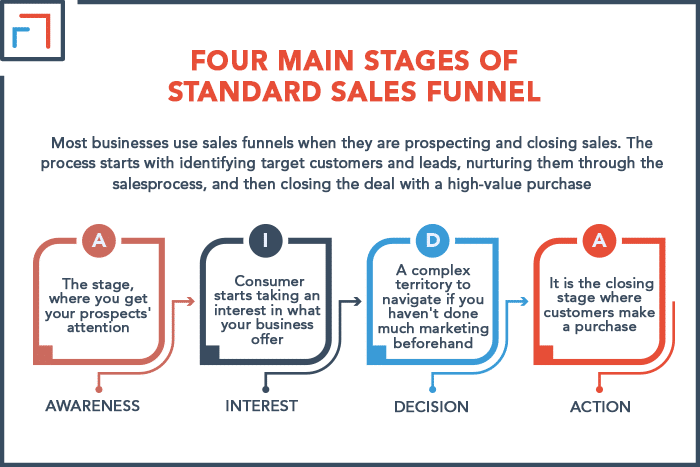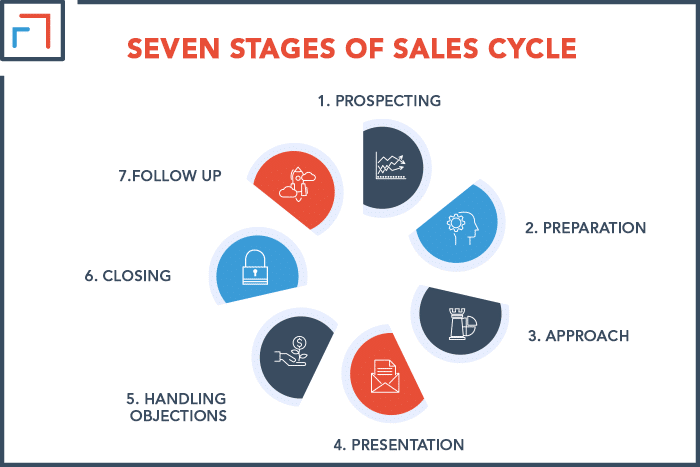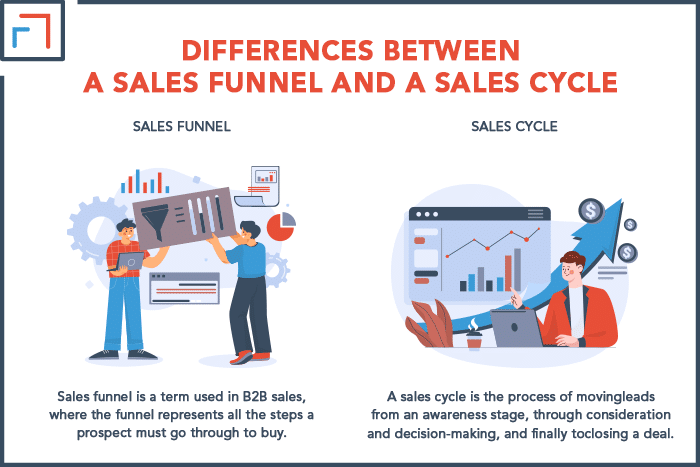Sales funnels and sales cycles are two fundamental processes that businesses use to drive leads through the customer journey. Both play a critical role in helping businesses create revenue. But how are they similar/different?
A sales funnel is a visual representation of the lead generation process, while a sales cycle is the series of steps taken from customer interest to purchase. The sales funnel is an ongoing process, unlike the sales cycle, which is more about completing certain steps to close the sale.
If you want to learn more about sales funnels and cycles, this guide has everything you need to know. Read on to learn more about the fundamentals of both processes so you can implement them effectively in your own business.
Sales Funnel vs Sales Cycle: Quick Comparison
Understanding the functions and differences between the sales funnel and sales cycle will maximize your success with new prospects.
| Sales Funnel | Sales Cycle |
|---|---|
| Focuses on converting leads into customers | Focuses on closing deals with customers |
| Shows you where you’re losing leads and making mistakes | Shows how long it takes to close a sale |
| It is an ongoing process | Has discrete steps |
| Designed to help you sell more products at higher volumes | Used to describe the process of converting an interested prospect into a customer |
What is a Sales Funnel?
A sales funnel is a visual representation of your company’s lead generation process. The purpose of a funnel is to help you understand where you’re losing prospects and how you can improve your chances of converting them into customers.
The process involves collecting information from potential consumers, determining whether they fit your ideal audience profile, and then converting those people into paying customers.
A funnel also helps determine how many people will make it through your sales cycle.
In a sales funnel, prospective customers take steps that move them from awareness to consideration to action and finally to purchase.
It’s a simplified representation of how people become aware of and interested in your product or service.
Most businesses use sales funnels when they are prospecting and closing sales.
The process starts with identifying target customers and leads, nurturing them through the sales process, and then closing the deal with a high-value purchase.
The standard sales funnel has four main stages:
1. Awareness
The top of the funnel is the awareness stage, where you get your prospects’ attention.
You might use social media to share information about your product or service. You could also pay for advertising on Facebook, Instagram, and Twitter.
Businesses should consider using content marketing services like Hubspot to generate leads for their website.
2. Interest
The next stage is interest. This happens when a consumer starts taking an interest in what your business offers, but they don’t necessarily have any idea what they want yet.
They’re still researching, talking with friends and family members, and asking questions. They’re still just looking around at all the options at this point!
3. Decision
Once your prospect has decided that they want something from you, they’ll move into the decision stage of your sales funnel.
It can often be a complex territory to navigate if you haven’t done much marketing beforehand.
But once someone has decided whether or not they’ll buy from you, it’s time for them to make a purchase decision.
4. Action
Once they’ve decided to try you out, the next stage is action: aka their first step toward buying something from you.
It is the closing stage where customers make a purchase. It can include many things like completing an online order form and entering payment information.
Action is the ultimate goal of any sales funnel because this is where you make money.

The Importance of Sales Funnels
A sales funnel is an integral part of any business because they are the thing that keeps your business moving forward.
They allow you to collect leads, nurture those leads, and convert them into customers.
Without a sales funnel, many businesses would have difficulty collecting the information they need to make a sale.
A good funnel will provide you with several ways for your customer to contact you.
This contact and the subsequent business relationship are essential for them to buy from you.
If you don’t have a good sales funnel, it will be hard for your customers to get in touch with you. It can lead to lost opportunities and diminished sales.
A sales funnel should also help improve your conversion rates (the percentage of people who become customers after following a link).
If this doesn’t happen, there’s probably something wrong with your sales process or product/service.
The purpose of a sales funnel is to increase the number of people who have reached at least one stage in your sales process.
Funnels can help you determine how to best position your product and make it appealing to customers.
A sales funnel also helps businesses identify the prospects that are most likely to close a sale.
It also highlights how many prospects drop out at certain stages, so you can focus on fixing flaws and bringing those numbers up.
What is a Sales Cycle?
A sales cycle is the series of steps that occurs when someone expresses interest in your product. It covers the time from when a prospect first hears about your product or service to when they make their first purchase. The sales cycle also encompasses the time a lead takes during each stage of a funnel.
Each step has associated KPIs (key performance indicators), that can be used to measure how well each stage performs.
The sales cycle as a process takes place from the moment a buyer decides that they need a product or service until payment for it is received.
It’s also called the buying process in some circles. The sales cycle includes seven stages:
1. Prospecting
This is where you identify potential customers who might be interested in what you’re selling.
Interest in your product or service is created through advertising, word-of-mouth referrals, or other promotion methods.
At this point, a prospect has not yet decided whether or not they will buy from you. In fact, the prospect hasn’t even decided to look for a solution to their problem.
2. Preparation
Preparation involves obtaining all necessary information about the customer’s needs and any special requirements they may have (such as databases that need to be accessed).
To price your proposal properly, you must also understand their budget and time constraints.
Pricing should be based on these factors and any additional costs involved with providing your solution (for example, travel costs).
3. Approach
When a prospect contacts you and agrees to do business with you, they move into the “approach” stage of the sales cycle.
Here, they will review their budget and decide which products and services they want to purchase from you.
4. Presentation
When you make an offer, and the customer accepts it, it’s time for them to receive their order!
For this process to work effectively, a business needs to provide accurate information about what was sold and when.
There are several different methods for gathering data about your customers so that you can send out invoices at regular intervals throughout the year.
The most common method is through point-of-sale systems.
5. Handling Objections
When dealing with a new potential customer, there’s always some degree of risk involved (especially if they don’t have any interest in buying from you).
This means there’s also some degree of uncertainty and competition between firms.
It is therefore essential to train your sales team on how to handle objections properly.
6. Closing
Once you’ve created value for your customer and ensured they understand how your product/service solves their problem, it’s time to close deals!
Finishing a deal with your prospect goes beyond engaging them; you’re preparing them for the next step.
You can go ahead and ask them for a starting date or even make an offer if they sign up immediately.
7. Follow-Up
Even after closing a deal with a prospective customer, the sales cycle doesn’t end. You need to make a follow-up for two reasons: Repeat business and referrals.
The follow-up is also essential for prospects who are not ready to say yes to your deal.
Checking on them regularly might be enough to convince them to buy from you and maybe even become repeat customers.

The Importance of Sales Cycle
The sales cycle is an essential element in creating a successful business.
It’s a way to measure how long it takes from when you get an order from your customer until you are paid for it.
The shorter the sales cycle is, the more money you make.
A sales cycle is vital because it gives you a close-up look at the overall process of moving through the sales funnel.
It makes it easier to see how long it will take for you to make a sale. The information helps you forecast your revenue and manage your teams more effectively.
A sales cycle also makes it easier for you to prioritize your prospecting efforts.
By understanding which stage a prospect is in, you can focus your efforts on the people that are most likely to buy from you.
You can’t just generate leads and then turn them directly into customers. First, you have to build relationships with your leads.
That means you must understand what they need and build trust with them so that they want to buy from you in the first place.
Differences Between a Sales Funnel and a Sales Cycle
A sales funnel and sales cycle both play an important role in the success of businesses. However, they differ in terms of operation.
Main Differences
Sales funnel is a term used in B2B sales, where the funnel represents all the steps a prospect must go through to buy.
On the other hand, a sales cycle is the process of moving leads from an awareness stage, through consideration and decision-making, and finally to closing a deal.
It’s how you get prospects from awareness to action.
The main difference is that when you’re building a sales funnel, you have one specific goal: getting someone to buy your product or service.
But when you’re building your sales cycle, you want to get many people through it so they can see what your product or service can do for them.
If they are well informed, this makes their decision easier.
While a sales funnel helps show what is happening in your sales process, a sales cycle shows how long your process takes from start to finish.
A sales cycle is longer than the sales funnel since it allows you to account for the drawn-out process of moving through each stage.
It uses multiple steps to contact customers and determine their needs, whereas a sales funnel consists of one stage at a time.
A sales funnel is a marketing tool that helps you build an audience around your brand. It’s an effective way to generate leads and convert them into paying customers.
A sales cycle is when a customer moves from the first interaction with your brand to the point where they become a paying customer.
You can think of it as covering the steps from conception to purchase.
Other Differences
A sales funnel is a simple concept that helps you visualize the entire process of getting customers through your sales pipeline.
It’s also useful for determining how many leads are generated, how many qualify as high-quality leads, and how many ultimately convert.
A sales cycle is a more complicated concept that includes multiple stages.
It starts with the idea generation stage and ends when the buyer completes their purchase. A sales funnel breaks down the customer journey into discrete stages.
It’s used to help marketers and salespeople better understand how to convert leads into customers and optimize their return on investment (ROI) throughout the sales cycle.
On the other hand, a sales cycle is when a customer interacts with a product or service provider to complete a goal or achieve an outcome.
The entire process of buying and using an item can be broken down into distinct phases, each with its own steps and milestones.
A sales funnel is the starting point for your business. It’s where you first get prospects to buy from you.
It’s where you develop relationships with your potential customers, get them to start talking about what they want, and help them find the perfect solution for their needs.
In contrast, a sales cycle begins after a prospect has reached a certain point in the funnel and could include several interactions between the two parties.
Some of those interactions could be marketing campaigns, sales calls, or emails — but they’re all part of one process that leads up to conversion and closing deals.

Final Thoughts
A sales funnel is a process that helps you to create a seamless and predictable customer journey from awareness to conversion.
It can be as simple as a series of emails or as complex as a multi-step process that includes landing pages, content creation, and other activities.
A sales cycle is the overall cycle of an organization’s sales efforts.
It encompasses all the activities involved in closing deals with customers, including planning, lead nurturing, scheduling appointments, meeting with prospects, and closing the deal.
